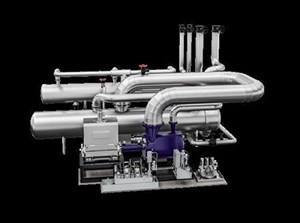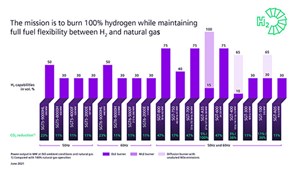Articles
Drive the decarbonization of chemical plants through energy efficiency enhancements
Executive Viewpoint: H2 Equipment and Services
J. HOOPER, Senior Vice President, Electrification, Automation and Digitalization, Siemens Energy
Like all process industries, the chemical sector is under intense pressure to drastically reduce its carbon footprint and reach net-zero emissions by 2050. While decarbonizing the process industries is critical to resolving the energy trilemma—energy transition, security and affordability—achieving this will be no easy task. Among all industrial sectors, the chemicals industry is the largest energy consumer. Additionally, at 923 MMtpy of carbon dioxide (CO2) emissions, it is third in direct carbon emissions (only the cement and steel industries have a higher carbon footprint).1
In the medium to long term, transitioning from traditional fossil fuel-based energy sources in favor of renewables and other low-carbon alternatives will be critical to meet emissions targets outlined by the International Energy Agency (IEA) and other organizations. However, this shift cannot happen overnight. To this end, operators must begin looking at what actions they can take to prepare their businesses for success in a low-carbon future.
Enhancing the energy efficiency of existing assets via modernization has proven to be one of the fastest ways to reduce a facility’s emissions profile incrementally. Modernization projects can have a positive impact, with many delivering CO2 reductions at costs as low as €10/t–€30/t.
This article highlights some of the specific technologies and concepts the author’s company is seeing with its customers deploying and discussing how the broader chemicals industry can benefit by embracing a more collaborative engagement model regarding decarbonization.
Brownfield engine exchanges (BEXs). Power generation and heat production are typically among the largest sources of emissions for chemical facilities that do not utilize grid electricity. This is particularly the case for sites with power or cogeneration plants commissioned decades ago. BEX projects focus on replacing obsolete equipment in these plants (e.g., gas turbines) to reduce emissions while avoiding significant production disruptions.
In recent years, the author’s company has performed major BEXs for industrial customers worldwide. One notable project commenced in a 2019 agreement with BASF to upgrade a combined-cycle (gas-fired) power plant at a chemical production site in eastern Germany. The project aimed to reduce overall emissions from the power plant and enable BASF to expand its onsite production capacities sustainably. Another objective was to provide the basis for future integration with renewable energies.2
The project involved replacing a decades-old gas turbine on one power line with a more fuel-efficient unit.a This enabled BASF to increase the plant’s output from 45 MW to 52 MW. In addition, the existing generator in the plant was modernized. The author’s company also installed a battery energy storage system for emergency power supply and to enable the black start of the power plant without relying on external sources.
Together, the combination of the new gas turbine and refurbished generator, along with other facility upgrades, resulted in a 10% increase in the efficiency of the power plant. This translated into lower fuel costs per kilowatt-hour (kWhr) and greenhouse gas (GHG) emissions reductions of approximately 16%. All of this occurred without interrupting production at the plant—an open-heart surgery of sorts.
For many facilities, replacing aging gas turbines also opens additional opportunities for emissions reductions by burning residual gases such as hydrogen (H2) in combination with natural gas (FIG. 1). The proprietary gas turbinea, for example, is already capable of burning fuel streams with up to 75 vol% H2. By 2030, the author’s company intends to have gas turbines operating on 100% H2 fuel. This includes installed units, designed to allow for future conversion to 100% H2 if/when it becomes available.
Use of industrial heat pumps. Over the next three decades, industrial heat demand is projected to grow by nearly 30% above its current level. Today, most of the heat generated for chemical production processes is produced via natural gas-fired boilers, resistive heaters, or extracted from hot exhaust streams of gas or steam turbines in combined heat and power plants.
While these equipment setups are proven and often highly efficient, modern heat pumps can sometimes represent an even more efficient option—with coefficients of performance (COP) > 4. This means four times as much heat energy is provided to the heat sink than the electricity consumed.
State-of-the-art industrial-scale heat pumps (FIG. 2) can achieve temperatures of up to 150°C with pressure ranges of up to 5 bar. Temperatures as high as 300°C and pressure levels up to 85 bar are possible when combined with steam compression. These capabilities are well within the range of many batch processes’ heat demands. Real-world installations have demonstrated that even with steam compression, which reduces efficiency, an overall COP of 3 can still be achieved.

By replacing traditional boilers with modern electrically driven heat pumps, the need to burn gas is significantly reduced, resulting in a corresponding decrease in direct plant emissions. In some cases, operational expenditure (OPEX) is also reduced because electricity can be purchased at a lower cost than gas.
Electrification with hybrid drives. Generating the necessary horsepower for process compressors can significantly reduce emissions and OPEX for a chemical facility. Selecting the type of machine to perform this duty has historically been a choice between an electric motor or a mechanical-drive solution, such as a gas turbine. In certain cases, a compelling case can be made for combining one or more mechanical drive components with an electric motor (or motor generator) into a single hybrid/dual-drive train.
A hybrid/dual-drive provides added operational flexibility by allowing producers to use either grid electricity or gas as an energy source for compression, whichever is more beneficial at the time. Many oil and gas facilities already capitalize on this concept by installing two separate compression trains (one motor-driven and one mechanically driven). A hybrid system serves the same purpose, often with a corresponding reduction in capital expenditure (CAPEX) because the requirement for ancillary infrastructures, such as foundations, piping, wiring, cabling, electrical systems and balance of plant, is eliminated.
One example where a hybrid drive can be especially impactful in terms of emissions reductions is when renewables make up a large part of the grid’s power generation mix. In such cases, the use of electric motor-driven compression is attractive. However, the inherent intermittency and instability of the grid means that some form of reliable backup is needed. Electricity costs during peak hours can also be extremely high.
With a hybrid drive, an operator can use the electric motor to drive the compression train during off-peak hours, presumably when the grid is stable and prices are low. If electrical power is unavailable or becomes cost-prohibitive, the mechanical drive gas turbine installed on the opposite shaft end of the compressor can be started up. In this way, plant operators can ensure that contractual obligations for production are never in jeopardy.
The electric motor can be designed to dually work as a generator, which means that any extra energy from the gas turbine after compression duties are met can produce electricity. The electricity can be used onsite if needed, or it can be sold back to the grid.
In recent years, the author’s company has installed hybrid drives for oil and gas customers, including upstream production sites, liquified natural gas (LNG) plants, pipeline stations and refineries. The concept can also be applied to exothermic chemical processes that utilize steam turbines and hot gas expanders.
Carbon, capture, utilization and storage (CCUS). If boosting plant efficiency helps decrease a facility's emissions, CCUS offers a way to avoid them altogether.
Much of the chemical industry’s carbon emissions stem from steam methane reforming (SMR), where syngas (H2 and carbon monoxide) is produced from natural gas at high temperatures and 20 bar–30 bar pressures. This is still the most widely used method of producing H2—gray H2—if the CO2 is released directly into the atmosphere. However, the emissions can also be compressed and sequestered for storage underground or reclaimed for further usage. H2 produced via this method is often referred to as blue H2.
In certain areas, there may be opportunities to combine captured CO2 with zero-emissions green H2 to produce climate-neutral eFuels, such as eMethanol or eAmmonia. However, because green H2 production depends on low-cost renewable electricity, eFuel plants are only commercially viable in very select regions where conditions are favorable.
The author’s company is involved in developing several such projects, such as a partnership with Sweden-based Liquid Wind AB to develop an eMethanol plant in Sweden (FIG. 3). The plant will use an electrolyzer powered by renewable energy to split water into green H2 and oxygen. The green H2 will be combined with CO₂ captured from the flue gas of a nearby biomass plant to yield carbon-neutral methanol.3

As much as 70,000 tpy of CO2 will be captured at the facility and combined with green H2. The plan is to produce 50,000 tpy of carbon-neutral eMethanol. Methanol will replace hydrocarbon fuels in shipping operations, preventing the emissions of approximately 100,000 tpy of CO2.4 As global demand for eFuels and other feedstocks derived from CO₂ increases, it is likely that similar opportunities for sector coupling in the chemicals industry will emerge.
Forging strong partnerships. Successfully navigating the energy transition and achieving deep decarbonization is not something any single company can achieve. Instead, it will require a long-term vision and collaboration from many stakeholders across process industries.
In improving energy efficiency, the chemical industry can benefit from forming strategic partnerships with suppliers and original equipment manufacturers (OEMs) that fully utilize each respective party’s strengths. Producers certainly possess the engineering and project management experience to drive successful modernization projects; however, the expertise of technology providers is also needed to identify synergies and optimize systems around any potential constraints.
The energy transition is the most effective investment program since the dawn of industrialization. Co-creation is needed to achieve the best possible outcome. If governments, businesses and society work together, energy transition represents a great opportunity.H2T
NOTE
a Siemens Energy’s SGT-800 gas turbine
LITERATURE CITED
1 International Energy Agency, “Direct CO2 emissions from primary chemical production in the net zero scenario, 2015-2030,” October 2022, online: https://www.iea.org/data-and-statistics/charts/direct-co2-emissions-from-primary-chemical-production-in-the-net-zero-scenario-2015-2030
2 Liquid Wind, “Making a power plant future fit - a tailor-made solution for BASF,” online: https://www.siemens-energy.com/global/en/offerings/references/basf.html
3 Siemens Energy, “Siemens Energy partners with Liquid Wind to produce green fuel,” online: https://www.liquidwind.se/news/siemensenergypartnerswithliquidwind
4 Liquid Wind, “CO2 secured for first eFuel facility,” online: https://www.liquidwind.se/news/ovikenergi
About the author

JENNIFER HOOPER is the SVP for Siemens Energy’s Electrification, Automation and Digitalization group for the Transformation of Industry Business. She joined Siemens Energy in 2020. Prior to this, Hooper held positions of increasing responsibility with TechnipFMC (formerly FMC Technologies Inc.). She earned an MBA from the University of Saint Thomas in Houston, Texas, U.S.


